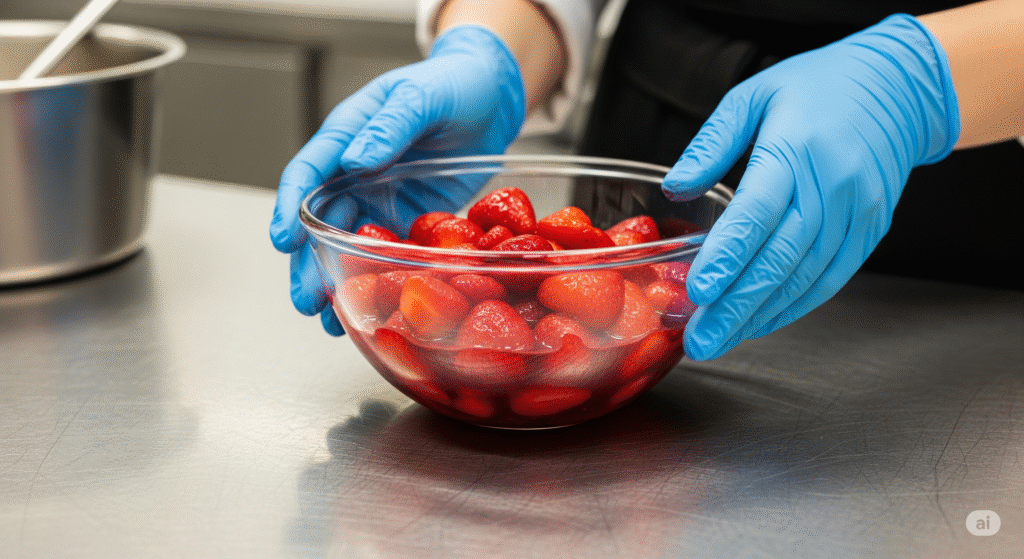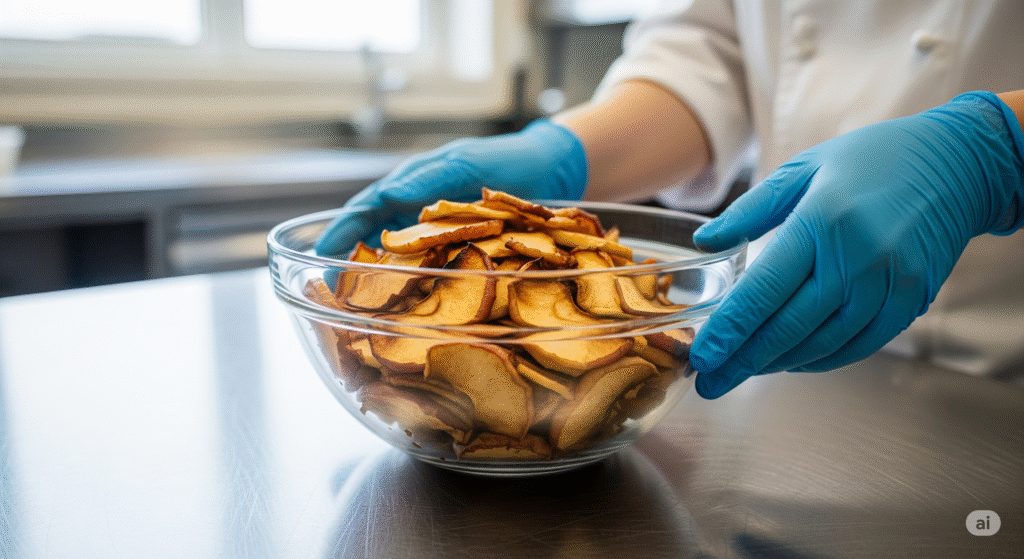Hello everyone, and welcome back to our series, Ingredients Under the Lens!
Fruit maceration is a gesture in pastry that feels like a promise. It’s the act of sprinkling fresh fruit with sugar and then waiting. his technique, fruit maceration, transforms the fruit in minutes: shiny droplets appear on its surface, evolving into a dense, fragrant syrup. It’s a wait filled with the sweet scent of summer desserts, ice cream sundaes, and flavor-rich tarts.
But what is really happening in that bowl? Is it just “fruit with sugar,” or is there more to it? And how can we control this process to get the exact result we want, without browning or unbalanced flavors?
Today, we’re putting not an ingredient, but a transformative technique under our lens: maceration. We’ll discover that behind this simple gesture lies fascinating physics, and understanding its rules means moving from “mix and hope” to total flavor control, turning a good ingredient into an extraordinary protagonist.
Fruit transforms thanks to the action of sugar: it’s not by chance, but the fascinating science of osmosis. #ConsciousMaceration
The Technical Eye: An In-Depth Analysis
Maceration is a culinary technique that involves leaving a food (usually fruit or vegetables) in contact with another compound (liquid or solid) to extract or transfer flavors. Let’s look at the key players in this process.

Strawberries during the maceration process: the sugar draws out the juices, creating a natural and aromatic syrup.
Osmosis: The Invisible Dance of Liquids
When we sprinkle fruit with sugar, we trigger a powerful physical phenomenon called osmosis. The fruit’s surface acts as a semi-permeable membrane. The sugar (the solute) creates a high-concentration external environment, “calling” the water from inside the fruit’s cells (where the concentration is lower) to try to rebalance the system. The result? Water is drawn out, creating a delicious syrup, and the fruit partially dehydrates, concentrating its flavor and softening its flesh.
The Solvent: The Orchestra Conductor The liquid or solid in which we immerse the fruit is the solvent, and its choice is crucial for the final result.
- Sugar: Extracts a lot of water, creating dense, sweet syrups.
- Alcohol (Liqueurs, Wines): A very powerful solvent, capable of extracting aromatic compounds that water cannot capture, and it also acts as a preservative.
- Acids (Lemon Juice, Vinegar): Besides contributing to the flavor, an acidic environment modifies protein structure and, as we will see, is a great ally.
Fruit Maceration vs. Oxidation
It’s essential not to confuse these two processes. Enzymatic oxidation, as we’ve seen in a previous article, is the browning process caused by the enzyme polyphenol oxidase reacting with oxygen. It is a form of degradation. Maceration, on the other hand, is a controlled and deliberate technique to improve an ingredient. In fact, maceration often fights oxidation because the liquid (lemon juice, syrup) creates a barrier that protects the fruit from contact with the air.
The reaction of the enzyme polyphenol oxidase with oxygen causes apples to brown, a product degradation process.
Time and Temperature: The Silent Regulators
The maceration time varies depending on the fruit and the desired result: 15 minutes may be enough for berries, while chopped apples might need an hour. Temperature speeds up the process, but for long macerations, the refrigerator is essential to ensure food safety and avoid excessive fermentation.

The effect of fruit oxidation: in contact with air, apples turn brown. A degradation process not to be confused with maceration.
In Practice: Scientific Problems and Solutions
Armed with this knowledge, we can solve common problems with precise solutions.
Problem: “I want a fruit topping for my panna cotta, but I’m afraid it will release water and make the bottom soggy.”Solution: Use fruit maceration to your advantage. Cut the fruit (e.g., strawberries), add 15% of its weight in sugar and the juice of half a lemon. Let it macerate for 30 minutes. Separate the fruit, now firmer and more flavorful, from the syrup. Use the fruit for decoration and the syrup, perhaps slightly reduced over heat, as an accompanying sauce. Total control.
Problem: “I want to naturally flavor a soaking syrup for my sponge cake.” Solution: Prepare a simple syrup (equal parts water and sugar, brought to a boil). Turn off the heat and infuse it (which is a form of hot maceration) with untreated lemon peels or fresh mint leaves. Let it rest for at least an hour. The heat will accelerate the release of essential oils, giving you an incredibly fragrant cake soak.
Problem: “My sangria is sometimes amazing, and other times it just tastes like wine with fruit floating in it.” Solution:The secret to a great sangria is proper fruit maceration! Cut the fruit (peaches, oranges, apples), sprinkle it with a couple of tablespoons of sugar and a bit of the liqueur you’ll be using (e.g., brandy or Cointreau). Let it macerate for at least 30 minutes before adding the wine. This first step extracts the intense juices and flavors from the fruit, which will then blend perfectly with the wine.
Pro Tip: The Perfect Maceration to Enhance Flavor
Want an explosion of taste to garnish ice cream or yogurt? Take some mixed berries or strawberries, chop them, add about 10% of their weight in sugar (e.g., 25g of sugar for 250g of fruit) and a tablespoon of lemon juice. Mix gently and let it rest in the fridge, covered, for an hour. The slow, cold-controlled osmosis will create an incredibly aromatic natural syrup and fruit that is still firm but bursting with flavor.
Conclusion: Science is Your Secret Ingredient
Understanding fruit maceration means you stop being subject to your ingredients’ reactions and start guiding them. It’s a technique that allows us to concentrate flavors, create new textures, and protect our raw materials. It’s no longer just “leaving fruit in sugar,” but a conscious dialogue between physics and chemistry happening right in our kitchen.
I hope you now look at this gesture with new eyes, seeing the incredible potential that knowledge allows you to unlock to make every one of your desserts unique.
Now it’s your turn! What’s your favorite maceration, the one that gives you the most satisfaction in your baking? Tell me about it in the comments below, let’s build our #HonestOven together!
Katia Oldani, Biologist Pastry Chef
Click here to Visit My YouTube Channel

